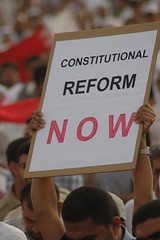Tuesday, November 16, 2004
The Island of a Million Palm Trees
Bahrain was once a tropical paradise, as all history books reveal, but now we need to pay millions of dinars for landscape architects to artificially recreate natural environments which we have spent years cementing over. Im not a hippy or part of any tree-hugging brigade, but I love nature. A post-modern cosmos of steel, glass and concrete and the capitalist market has condemned nature to scenic postcards or the school trip to the zoo. That’s about as close to nature that we get these days. Even trying to find a patch of natural coastline in Bahrain is becoming mission impossible– and NO, the beach at the Ritz-Carlton doesn’t count, it is 100% man-made, the palm trees and the sand are imported!! Instead of deforestation, we have dePALMisation (i made that up but what is a better word??), the satellite image below of Nabeeh Saleh island illustrates this: Nabeeh Saleh Island in 1954 and in 1998
We live on an island yet what beach can you go to on a day out with the kids? Tubli Bay has gone from 24km to 10km due to coastline alterations and places like Sa7il Abu Sub7 in Duraz is not the best place to go paddling. Land reclamation leaves the coastline muddy, rocky and jagged. Where sewage is dumped offshore, I have seen it washing up on some coasts, with some coastlines being the closest rubbish dumps to dispose of waste. There was ONE project of opening a public beach I think somewhere near Hidd, but with over a 150 kilometers of coastline, this isn’t going far enough. I haven’t even touched on the danger that dredging sand from the sea bed poses on marine life and the coral reefs that Bahrain is famous for. Its hardly surprising that Bahrain (along with most other Arab countries) has not signed up to the Kyoto protocol against global warming, as the environment is about as important to the government as Alsaiidi’s bumfluff. Hell, they're reclaiming land so fast that map drawers can't even keep up. Yet 40% of the southern part of the island is a 'restricted area' off-bounds to the populace.
In the UAE, Sh. Zayed succeeded in turning a desert into arable land, and planted millions of palm trees. In Bahrain, which was once called the ‘island of a million palm trees’ we have conversely succeeded in turning arable land into desert. Increasing land prices and higher demand for land has meant the commercial value of a mazra3a or a public park is no longer viable in certain areas. Following the rapid industrialisation during the 1970s and 80s, the government’s failure in imposing strict guidelines and investing in the protection of preserved areas like the ‘green belt’ in South-West England has meant that we’ll be lucky if we have a single home-grown palm tree left on the island. Palm trees are considered a luxury piece of décor only fit enough to line the streets or Rifaa leading to the Kings palace in Safrya.
The damage is done on mainland Bahrain, but with a little TLC and a few palm trees seeds we might just be able to restore some of the island’s former glory. Oh yes, and how could I forget that the PM and the King have kindly left a few islands untouched, namely Jedda, Um Nasan (which you can see from the Causeway) and Um Sobban, which they have been confiscated for private use. At least there is some preservation going on, I hope they enjoy it!!





Read or Post a Comment
INTERIM ENVIRONMENTAL REVIEW OF THE U.S.- BAHRAIN FREE TRADE AGREEMENT
[Bahrain faces environmental challenges common to many Middle Eastern countries: desertification resulting from degradation of limited arable land; periodic drought and dust storms; damage to coastal areas resulting from dredging, oil spills and other discharges from refineries and oil distribution; air pollution, which is exacerbated by extreme summer temperatures; and a shortage of freshwater resources.
Bahrain’s marine environment and natural resources are especially stressed as a consequence of pollution, over-exploitation and coastal development projects that require extensive dredging and land reclamation. The most important sources of pollution include oil spills from accidents, exploration, shipping and loading operations. Additional sources include treated, partially treated and untreated domestic sewage, agricultural and industrial wastes that are discharged directly and indirectly into shallow coastal waters, causing eutrophication and other damage to coastal ecosystems. Bahrain’s marine environment, including its coral reefs, are also adversely affected by solid waste disposal.
Dredging and coastal reclamation projects put additional pressure on marine habitats, especially coral reefs. The consequences of these pressures are degradation of marine resources, declines in fish stocks and biodiversity loss. It is reported that about 82% of coral reefs in Bahrain’s marine area are endangered due to bleaching events and pollution. Bahrain has recently taken steps, however, to reduce dredging and protect sensitive ecosystems]
http://www.ustr.gov/assets/Trade_Agreements/Bilateral/Bahrain_FTA/asset_upload_file720_3078.pdf
I couldn't agree with you more Bahrania. I wrote a post about this a few months back here, and I've been meaning to do a follow up to it. One of the most obvious places where you can see palms dying is along the highway to the seef area (part of Sanabis). It used to be a dense palm forest and now the palms are left to die and rot. Sad.
Informative Site… Hello guys here are some links that contains information that you may find useful yourselves. It’s Worth Checking out….
Very educating story, saved your site for hopes to read more!
pitted dates | Organic dates exporters | Organic Chopped dates exporters | Dates exporters from pakistan | Pakistani dates exporters | Chopped dates exporters